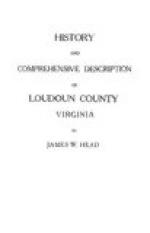“On the 15th of October (1861) General Banks’ division of the Federal army was located at Darnestown, Md., about fifteen miles due east from Leesburg, with detachments at Point of Rocks, Sandy Hook, Williamsport, etc.; while the division of Brig.-Gen. C.P. Stone, composed of six companies of cavalry, three of artillery, and the infantry brigades of Gens. W.A. Gorman and F.W. Lander and Col. E.D. Baker, was located at Poolesville, eight miles north of east from Leesburg. The object in this disposition of so large a force was, not only to guard the right of the big Federal army that General McClellan was gathering at Washington, but especially to cover the important approaches from the northwest to Baltimore and the Federal city, particularly those from the lower Shenandoah Valley and northeastern Piedmont, Virginia.
[Footnote 32: Virginia Military History, by Jedediah Hotchkiss.]
[Footnote 33: Also called “Battle of Harrison’s Island” and “Battle of Conrad’s Ferry.”]
“On October 19th, McCall’s Federal division advanced to Dranesville, on the road to Leesburg and about 15 miles from that place, ’in order to cover the reconnoissance made in all directions the next day;’ and later, Smith’s Federal division advanced along a parallel road to the west, acting in concert with General McCall, and pushed forward strong parties in the same direction and for the same purpose. About 7 p.m. of the 19th, Stone’s advance opened a heavy cannonade on the Confederate positions at Fort Evans, on the Leesburg pike, and at Edwards’ Ferry, and at the same time General Evans heard heavy firing in the direction of Dranesville. At midnight General Evans ordered his whole brigade to the front, along the line of Goose Creek, 3 miles southeast of Leesburg, where he had a line of intrenchments, to there await an expected attack from General McCall, the next morning, Sunday, October 20th, as it had been reported that the Federal advance was moving in force from Dranesville toward Leesburg. Evans’ scouts captured McCall’s courier bearing dispatches to General Meade, directing him to examine the roads leading to Leesburg. The Federal batteries kept up a deliberate fire during the day, but no assault was made.




